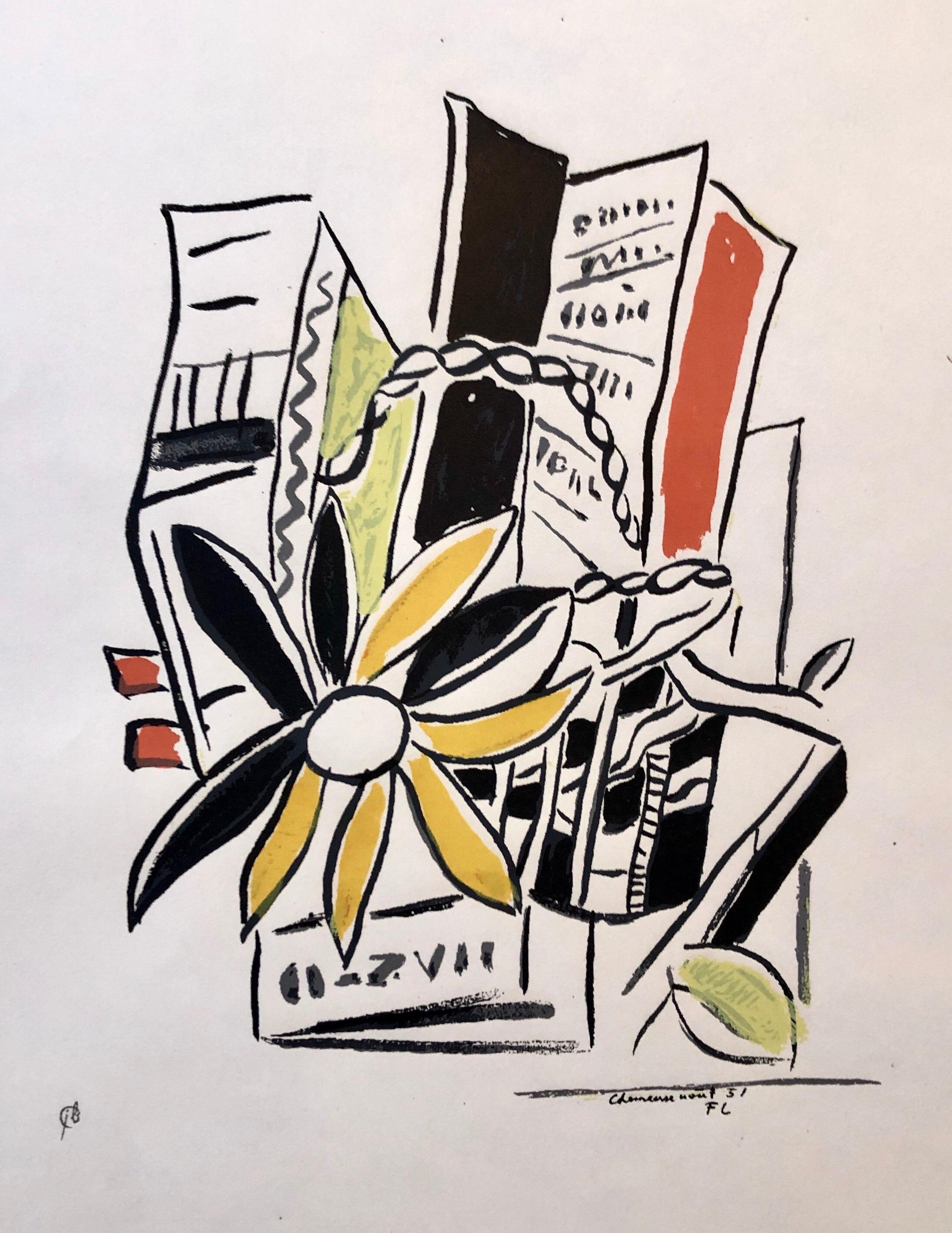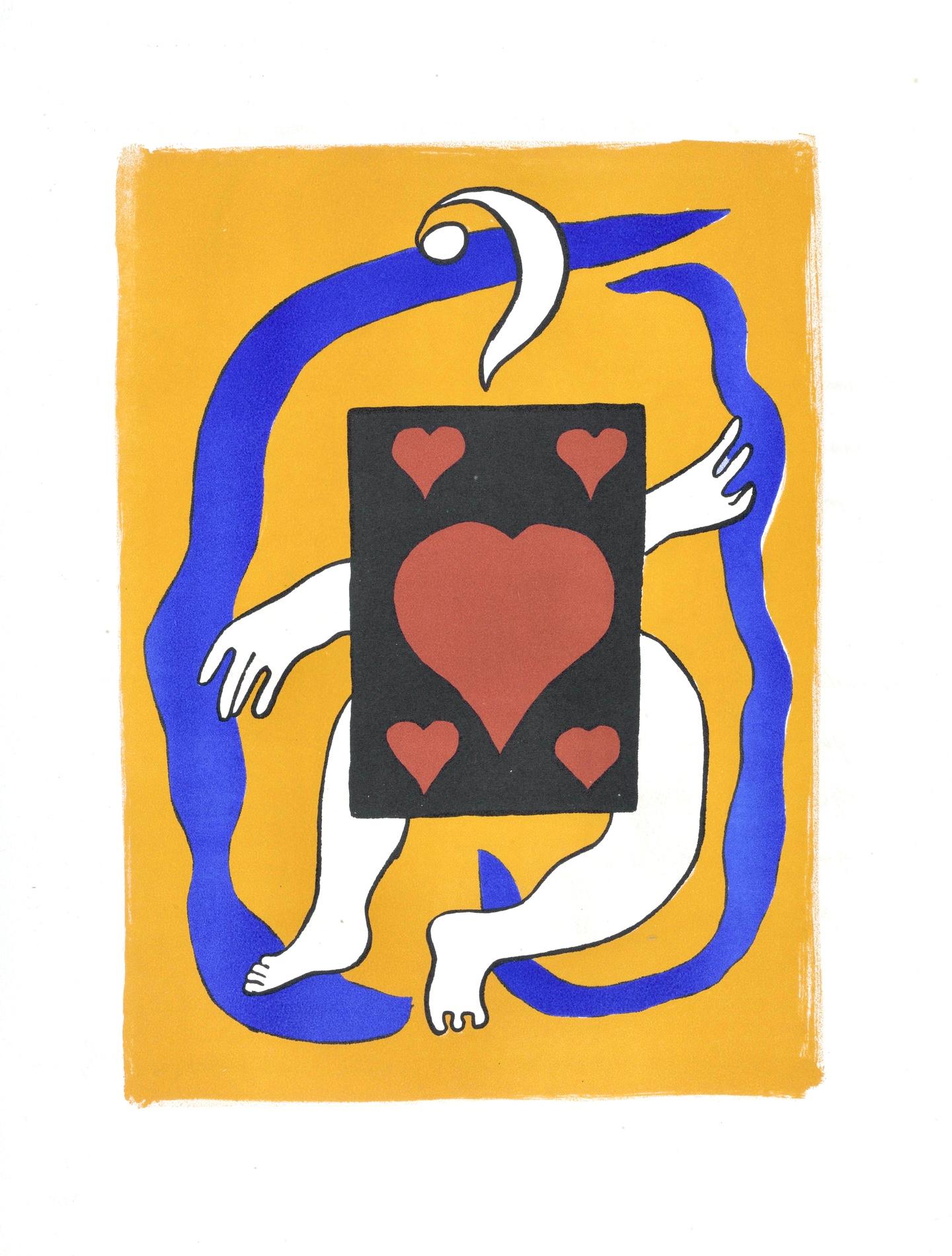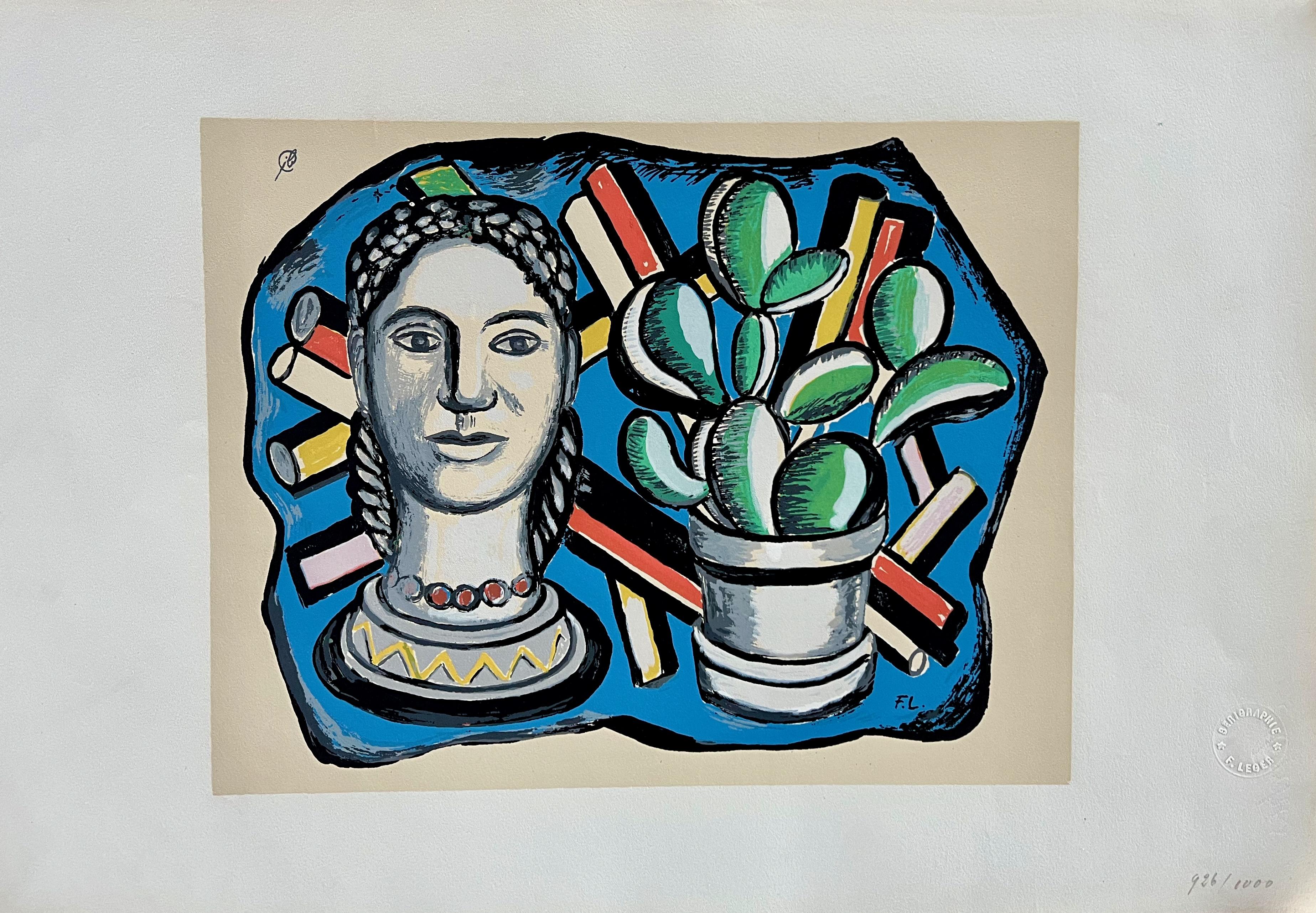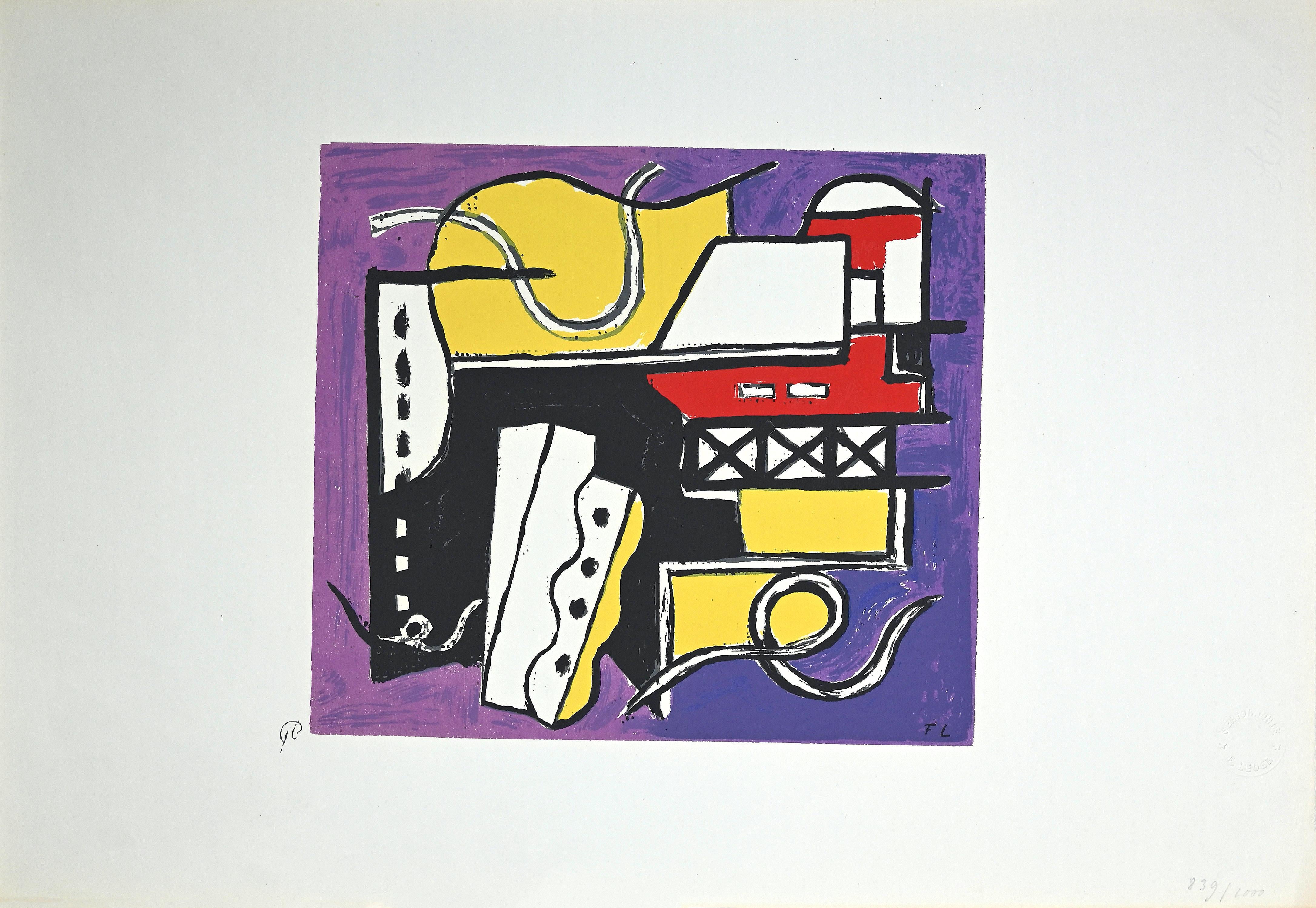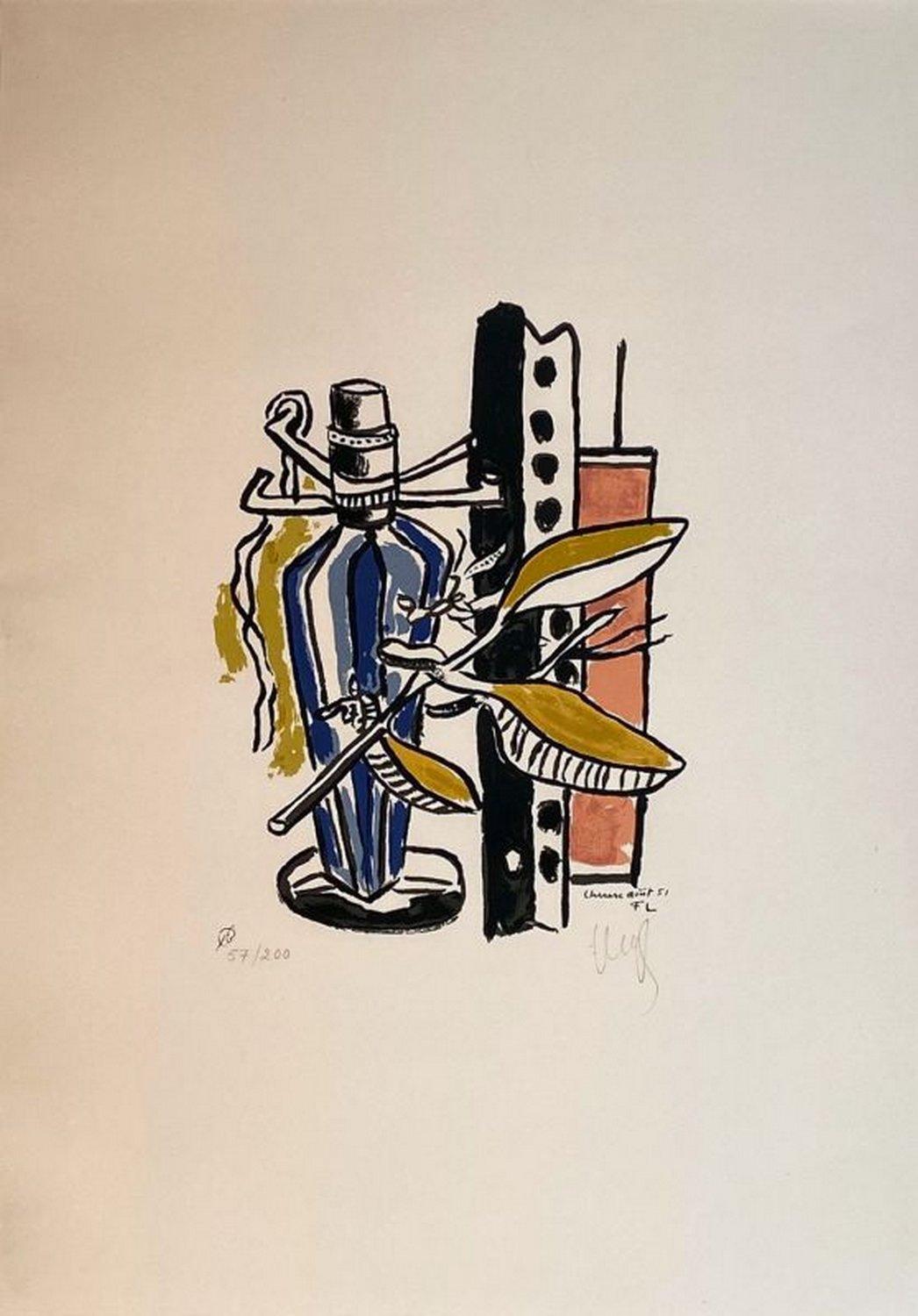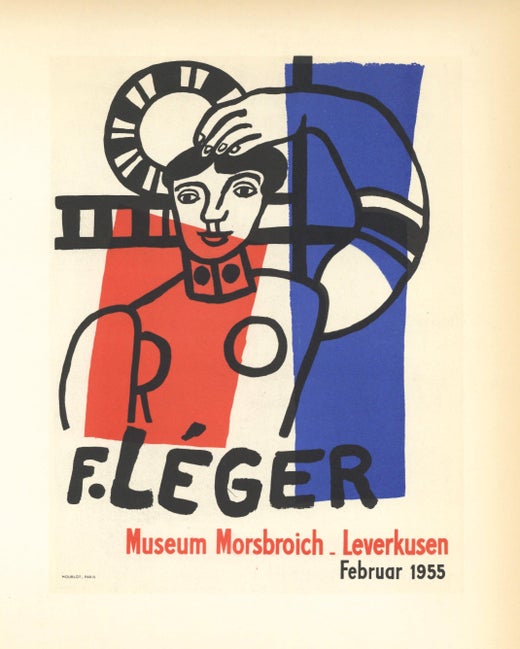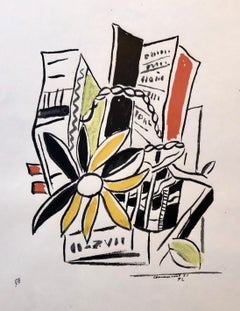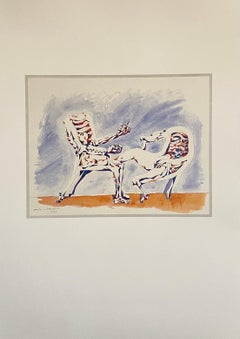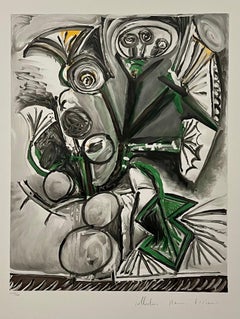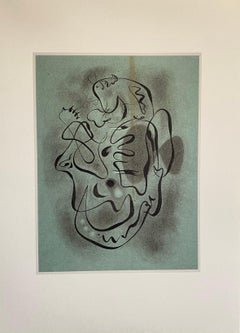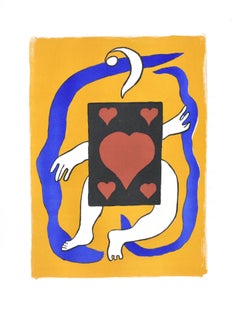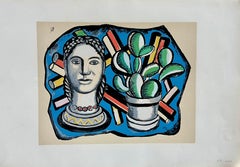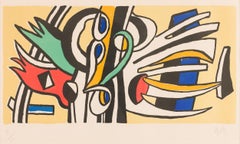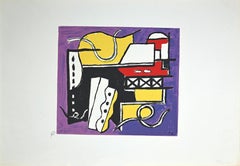Items Similar to Fernand Leger School Prints Colorful Modernist King of Hearts Drawing Lithograph
Want more images or videos?
Request additional images or videos from the seller
1 of 10
(after) Fernand LégerFernand Leger School Prints Colorful Modernist King of Hearts Drawing Lithographc.1949
c.1949
$1,800
£1,398.29
€1,586.58
CA$2,573.66
A$2,815.65
CHF 1,470.56
MX$33,647.68
NOK 18,475.57
SEK 17,388.43
DKK 11,848.31
About the Item
Bright vibrant blue, orange, red, yellow, green lithograph in color. This is signed in the plate and dated. Leger's abstract drawing lithograph was drawn by the artist direct on to plastic plates newly developed by Cowell's of Ipswich, and proofed under his supervision. The original edition called for 3000. I do not know how many were actually printed.
The sheer logistics of the operation, the costly effort of distribution to over 4000 schools, finally ended the great adventure of the School Prints scheme. The expensive endeavor peaked in 1949 with the magnificent European series, made possible by the plastic portable plates, which, in addition to Moore, featured Henri Matisse, Pablo Picasso, Fernand Leger, Raoul Dufy and Georges Braque.
Joseph Fernand Henri Léger (French 1881 – 1955) was a French painter, sculptor, and filmmaker. In his early works he created a personal form of cubism which he gradually modified into a more figurative, populist style. His boldly simplified treatment of modern subject matter has caused him to be regarded as a forerunner of pop art.
Léger was born in Argentan, Orne, Lower Normandy, where his father raised cattle. Fernand Léger initially trained as an architect from 1897 to 1899, before moving in 1900 to Paris, where he supported himself as an architectural draftsman. After military service in Versailles, Yvelines, in 1902–1903, he enrolled at the School of Decorative Arts after his application to the École des Beaux-Arts was rejected. He nevertheless attended the Beaux-Arts as a non-enrolled student, spending what he described as "three empty and useless years" studying with Gérôme and others, while also studying at the Académie Julian. He began to work seriously as a painter only at the age of 25. At this point his work showed the influence of impressionism, as seen in Le Jardin de ma mère (My Mother's Garden) of 1905, one of the few paintings from this period that he did not later destroy. A new emphasis on drawing and geometry appeared in Léger's work after he saw the Cézanne retrospective at the Salon d'Automne in 1907.
In 1909 he moved to Montparnasse and met Alexander Archipenko, Jacques Lipchitz, Marc Chagall, Joseph Csaky and Robert Delaunay. In 1910 he exhibited at the Salon d'Automne in the same room (salle VIII) as Jean Metzinger and Henri Le Fauconnier. In his major painting of this period, Nudes in the Forest, Léger displays a personal form of Cubism that his critics termed "Tubism" for its emphasis on cylindrical forms.
In 1911 the hanging committee of the Salon des Indépendants placed together the painters identified as 'Cubists'. Metzinger, Albert Gleizes, Le Fauconnier, Delaunay and Léger were responsible for revealing Cubism to the general public for the first time as an organized group.
The following year he again exhibited at the Salon d'Automne and Indépendants with the Cubists, and joined with several artists, including Le Fauconnier, Metzinger, Gleizes, Francis Picabia and the Duchamp brothers, Jacques Villon, Raymond Duchamp-Villon and Marcel Duchamp to form the Puteaux Group—also called the Section d'Or (The Golden Section).
Léger's paintings, from then until 1914, became increasingly abstract. Their tubular, conical, and cubed forms are laconically rendered in rough patches of primary colors plus green, black and white, as seen in the series of paintings with the title Contrasting Forms. Léger made no use of the collage technique pioneered by Georges Braque and Pablo Picasso.As an enthusiast of the modern, Léger was greatly attracted to cinema, and for a time he considered giving up painting for filmmaking. In 1924, in collaboration with Dudley Murphy, George Antheil, and Man Ray, Léger produced and directed the iconic and Futurism-influenced film Ballet Mécanique (Mechanical Ballet). Neither abstract nor narrative, it is a series of images of a woman's lips and teeth, close-up shots of ordinary objects, and repeated images of human activities and machines in rhythmic movement. In collaboration with Amédée Ozenfant he established a free school where he taught from 1924, with Alexandra Exter and Marie Laurencin. He produced the first of his "mural paintings", influenced by Le Corbusier's theories.
His varied projects included book illustrations, murals, stained-glass windows, mosaics, polychrome ceramic sculptures, and set and costume designs.
He was active as a teacher for many years, first at the Académie Vassilieff in Paris, then in 1931 at the Sorbonne, and then developing his own Académie Fernand Léger, which was in Paris, then at the Yale School of Art and Architecture (1938–1939), Mills College Art Gallery in Oakland, California during 1940–1945, before he returned to France. Among his many pupils were Hananiah Harari, Asger Jorn, Michael Loew, Beverly Pepper, Marcel Mouly, Louise Bourgeois, Tsuguharu Foujita, Sam Francis, Serge Gainsbourg, Hans Hartung, Florence Henri, Asger Jorn, William Klein, Maryan, Jules Olitski, Erik Olson, and Richard Stankiewicz.
In 1952, a pair of Léger murals was installed in the General Assembly Hall of the United Nations headquarters in New York City. In 1960, the Musée Fernand Légerwas opened in Biot, Alpes-Maritimes, France. In May 2008, his painting Étude pour la femme en bleu (1912–13) sold for $39,241,000 (hammer price with buyer's premium) United States dollars.
- Creator:(after) Fernand Léger (1881 - 1955, French)
- Creation Year:c.1949
- Dimensions:Height: 25.25 in (64.14 cm)Width: 35.5 in (90.17 cm)
- Medium:
- Movement & Style:
- Period:
- Condition:the piece is mounted to another paper for support, as issued. minor wear. the lithograph is in good condition with minor age toning commensurate with age. please see photos.
- Gallery Location:Surfside, FL
- Reference Number:1stDibs: LU38214212522
(after) Fernand Léger
This print is part of my private collection. They were published in a numbered unsigned edition of 1000, and a signed edition of 200, printed by Serifraphie Fernand Leger, Paris and published by La Guilde International de la Gravure, Jean Bruller 1954/55. Initials in plate. They are catalogued in Lawrence Saphire's "Fernand Leger- Complete Graphic Work." They come from a portfolio sute of 10 serigraphs after original Fernand Leger gouaches. Fernand Leger 1881-1955, French was one of the major Cubist painters in France, later he also became a sculptor, art educator and filmmaker. In the early 1900's he was influenced by Cezanne and began creating in a more geometric style. He created his own style called Tubism with emphasis in cylindrical forms. He was considered one of France's three major Cubist painters among Picasso and Georges Brayer. Leger was influenced by the Italian "Futurism" style.
About the Seller
4.9
Platinum Seller
Premium sellers with a 4.7+ rating and 24-hour response times
Established in 1995
1stDibs seller since 2014
1,830 sales on 1stDibs
Typical response time: 1 hour
- ShippingRetrieving quote...Shipping from: Surfside, FL
- Return Policy
Authenticity Guarantee
In the unlikely event there’s an issue with an item’s authenticity, contact us within 1 year for a full refund. DetailsMoney-Back Guarantee
If your item is not as described, is damaged in transit, or does not arrive, contact us within 7 days for a full refund. Details24-Hour Cancellation
You have a 24-hour grace period in which to reconsider your purchase, with no questions asked.Vetted Professional Sellers
Our world-class sellers must adhere to strict standards for service and quality, maintaining the integrity of our listings.Price-Match Guarantee
If you find that a seller listed the same item for a lower price elsewhere, we’ll match it.Trusted Global Delivery
Our best-in-class carrier network provides specialized shipping options worldwide, including custom delivery.More From This Seller
View AllFernand Leger Colorful Modernist Drawing Limited Edition Serigraph Lithograph
By (after) Fernand Léger
Located in Surfside, FL
Serigraph, from ''Album of Ten Serigraphs'' (1954-55), by Fernand Leger (French 1881-1955), signed and dated in plate lower right, printed by Jean Bruller, distributed by Galerie Int...
Category
1950s Modern Abstract Prints
Materials
Lithograph
French Abstract Surrealist Color Lithograph Andre Masson
By André Masson
Located in Surfside, FL
Published Benincasa Carmine. Edizioni SEAT, Torino, Italy. Offset directly from the original plates.
Limited edition. This is not hand signed or numbered. Signature in the printing p...
Category
20th Century Surrealist Abstract Prints
Materials
Lithograph, Offset
Pablo Picasso Estate Hand Signed Cubist Lithograph Abstract Flowers Bouquet
By Pablo Picasso
Located in Surfside, FL
Pablo Picasso (after)
"Le Bouquet" Bouquet of flowers, abstract floral arrangement.
limited edition print on Arches paper,
Hand signed by Marina Picasso lower right and numbered 244...
Category
20th Century Modern Abstract Prints
Materials
Lithograph
French Abstract Surrealist Color Lithograph Andre Masson
By André Masson
Located in Surfside, FL
Published Benincasa Carmine. Edizioni SEAT, Torino, Italy. Offset directly from the original plates.
Limited edition. This is not hand signed or numbered. Signature in the printing p...
Category
20th Century Surrealist Abstract Prints
Materials
Lithograph, Offset
Israeli Josef Zaritsky Abstract Modernist Lithograph Print "Composition"
Located in Surfside, FL
Abstract Composition, 1959 Lithograph
This was from a portfolio which included works by Yosl Bergner, Menashe Kadishman, Yosef Zaritsky, Aharon Kahana, Moshe Tamir and Michael Gross.
Joseph (Yossef) Zaritsky (Hebrew: יוסף זריצקי; September 1, 1891 – November 30, 1985) was one of Israel's greatest artists and one of the early promoters of modern art in the Land of Israel both during the period of the Yishuv (Palestine, the body of Jewish residents in the Land of Israel before the establishment of the State of Israel) and after the establishment of the State. In 1948 Zaritsky was one of the founders of the "Ofakim Hadashim" group. In his works he created a uniquely Israeli style of abstract art, which he sought to promote by means of the group. For this work he was awarded the Israel Prize for painting in 1959.
Joseph Zaritsky...
Category
1950s Modern Abstract Prints
Materials
Lithograph
French Abstract Surrealist Color Lithograph Andre Masson
By André Masson
Located in Surfside, FL
Published Benincasa Carmine. Edizioni SEAT, Torino, Italy. Offset directly from the original plates.
Limited edition. This is not hand signed or numbered. Signature in the printing p...
Category
20th Century Surrealist Abstract Prints
Materials
Lithograph, Offset
You May Also Like
Fernand Leger, Plate 90, from Circus, 1950
By Fernand Léger
Located in Southampton, NY
This exquisite lithograph by Fernand Leger (1881–1955), titled Planche 90 (Plate 90), from the album Cirque, Lithographies Originales (Circus, Original Lithographs), originates from ...
Category
1950s Modern Landscape Prints
Materials
Lithograph
Serigraphie Fernand Leger
By Fernand Léger
Located in Belgrade, MT
This print is part of my private collection. They were published in a numbered unsigned edition of 1000, and a signed edition of 200, printed by Serifraphie Fernand Leger, Paris and ...
Category
Mid-20th Century Abstract Expressionist Abstract Prints
Materials
Lithograph
$600 Sale Price
25% Off
Fernand Léger (1881–1955) – Composition murale – Lithograph on paper – 1951
By Fernand Léger
Located in Varese, IT
Lithograph on paper, edited 1951
Limited edition , numbered 8/50
Paper size: 50 x 65 cm
Very good conditions
Publisher : Pavillon français, Triennale de Milan
Printer : Mourlot, Par...
Category
1950s Abstract Prints and Multiples
Materials
Lithograph
Composition - Lithograph after Fernand Leger - Mid-20th Century
By Fernand Léger
Located in Roma, IT
Composition is a screen print realized after Fernand Léger in the mid-20th Century.
Monogrammed in plate and hand numbered in pencil lower right.
The composition is part of a colle...
Category
Mid-20th Century Cubist Figurative Prints
Materials
Lithograph
Album de 10 sérigraphies
By Fernand Léger
Located in Paris, FR
Lithograph, 1951
Edition : 57/200
Publisher : Guilde internationale de la Gravure (Genève)
Printer : Jean Bruller (Paris)
Catalog : Sapphire E7
56.00 cm. x 38.00 cm. 22.05 in. x 14....
Category
1950s Abstract Abstract Prints
Materials
Lithograph
Original French MCM Modernist Signed Abstract Lithograph Fernand Leger 1952
By Fernand Léger
Located in Portland, OR
Fernand Léger (1881-1955)
Femme sur fond jaune (Woman Against Yellow Background), 1952
Created in 1952, this original color lithograph is hand signed in ink by Fernand Léger (1881 - 1955) in the lower right margin. Printed by Fernand Mourlot, Paris out of the total edition of 150 unnumbered proofs on Arches wove paper. We at Bloomsbury Fine Art & Antiques can...
Category
1950s Modern Figurative Prints
Materials
Paper
More Ways To Browse
Vintage Plastic Plates
Alexandra Exter
Hananiah Harari
Richard Smith Orange
Salvador Dali Currier And Ives
Salvador Dali Illustration
Sam Francis Original
Vasarely Vega
Alberto Magnelli On Sale
Als Mestres De Catalunya
Antonio Calderara
Arthur Secunda Lithograph
Basquiat Bischofberger
Calder 1972
Camel Cigarettes Vintage
Chillida Poster
Damien Hirst Fruitful
Damien Hirst Kaleidoscope
